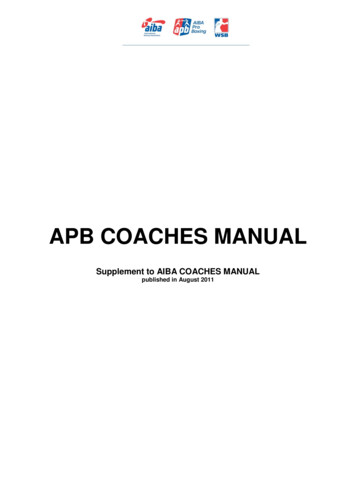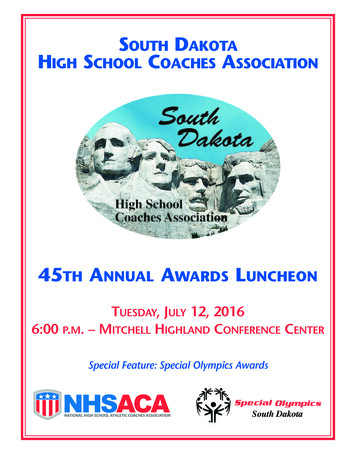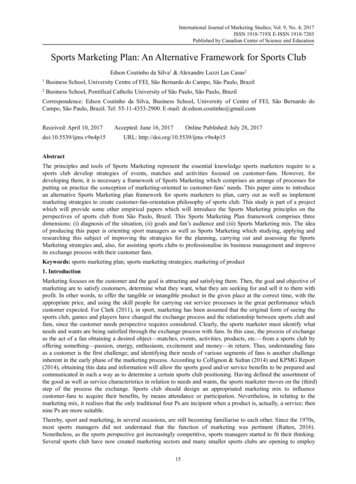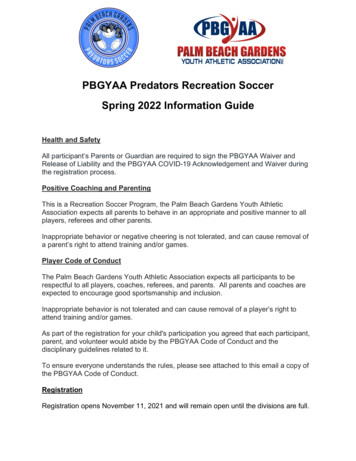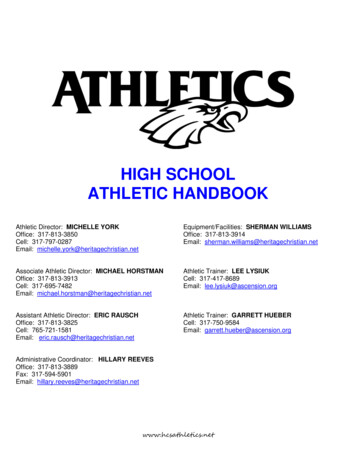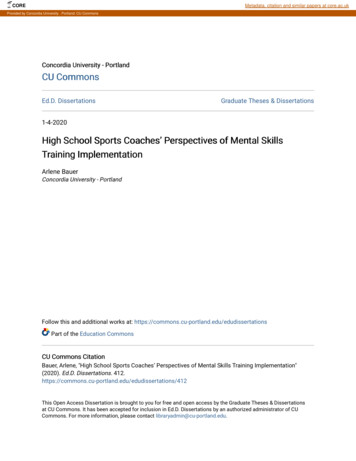
Transcription
COREMetadata, citation and similar papers at core.ac.ukProvided by Concordia University , Portland: CU CommonsConcordia University - PortlandCU CommonsEd.D. DissertationsGraduate Theses & Dissertations1-4-2020High School Sports Coaches’ Perspectives of Mental SkillsTraining ImplementationArlene BauerConcordia University - PortlandFollow this and additional works at: rt of the Education CommonsCU Commons CitationBauer, Arlene, "High School Sports Coaches’ Perspectives of Mental Skills Training Implementation"(2020). Ed.D. Dissertations. ns/412This Open Access Dissertation is brought to you for free and open access by the Graduate Theses & Dissertationsat CU Commons. It has been accepted for inclusion in Ed.D. Dissertations by an authorized administrator of CUCommons. For more information, please contact libraryadmin@cu-portland.edu.
Concordia University–PortlandCollege of EducationDoctorate of Education ProgramWE, THE UNDERSIGNED MEMBERS OF THE DISSERTATION COMMITTEECERTIFY THAT WE HAVE READ AND APPROVE THE DISSERTATION OFArlene Lynn BauerCANDIDATE FOR THE DEGREE OF DOCTOR OF EDUCATIONJulie McCann, Ph.D., Faculty Chair Dissertation CommitteeCatherine Beck, Ed.D., Content ReaderRobert Voelkel, Ed.D., Content Specialist
High School Sports Coaches’ Perspectives of Mental Skills Training ImplementationArlene Lynn BauerConcordia University–PortlandCollege of EducationDissertation submitted to the Faculty of the College of Educationin partial fulfillment of the requirements for the degree ofDoctor of Education inTransformational LeadershipJulie McCann, Ph.D., Faculty Chair Dissertation CommitteeCatherine Beck, Ed.D., Content ReaderRobert Voelkel, Ed.D., Content SpecialistConcordia University–Portland2020ii
AbstractThe purpose of this qualitative multiple case study was to gain an in-depth understanding of theperceived benefits and challenges that exist when implementing a Mental Skills Training (MST)program in high school sports, from the perspectives of high school sports coaches.Constructivism theory informed this study’s arguments about the role that the benefits andchallenges had on the coaches’ perspectives of MST. For this research, interactions with six highschool sports coaches took place through one-on-one virtual interviews and an asynchronousonline focus group. The primary research question that guided this study was, “How do highschool sports coaches perceive the benefits and challenges of implementing an MST program?”The conversations provided this researcher with an understanding of what the coaches learnedfrom their perceived benefits and challenges of implementing an MST program. Five majorthemes arose: (a) reasons for implementing MST, (b) structure of MST and topics, (c) perceivedeffects on athletic performance, (d) perceived effects on life skills, and (e) support. The findingsin this study can offer future high school sports coaches with relevant evidence about whetherMST programs are a viable method of improving high school athlete performance and life skilldevelopment.Keywords: Mental Skills Training (MST), high school sports, high school sports coachesperceptionsiii
DedicationThis dissertation would not be completed without the support of my husband, Darren, and ourson Reus. They spent many Saturday mornings at the San Gabriel River, and going out tobreakfast together so that “mama could work.” This research is dedicated to them.iv
AcknowledgmentsI wish to express my deepest gratitude to my dissertation committee chair, Dr. Julie McCann,who guided me to pursue a topic that I was passionate about studying. Dr. McCann, yourconstant support and feedback were invaluable in completing this research. I would like to, aswell, thank my committee members, Dr. Catherine Beck and Dr. Robert Voelkel, who wereincredibly helpful by suggesting new ideas and editing advice. I would also like to thank the highschool sports coaches who shared their experiences in this study. Without their passion fordeveloping athletes, this research would not exist.v
Table of ContentsAbstract. iiDedication. iiiAckowledgements. ivList of Tables . ixList of Figures. xChapter 1: Introduction .1Problem Statement .5Nature of the Study .6Research Questions .6Research Objective .7Purpose of the Study .7Conceptual Framework .8Definition of Terms .9Assumptions .10Limitations .10Scope and Delimitations.12Significance .12Summary .13Chapter 2: Literature Review .14Introduction .14The study topic .16The context of the study .17vi
The significance of the study .17The statement of the problem .18The organization of the chapter .19Conceptual Framework .20Review of Research Literature .23Life skills development in sport .25Strategies included in MST programs .26Comprehensive MST programs .29Perceptions of MST programs.33Athlete Perceptions .35Coach and Administrator Perceptions .36Review of Methodological Issues .38Synthesis of Research Findings .40Critique of Previous Research .41Summary .44Chapter 3: Methodology.46Research Questions .48Purpose and Design of the Study .48Target Population and Sampling Method.51Related procedures .52Instrumentation.53Data Collection .53Recruitment Survey .53vii
One-on-one e-interview .54Asynchronous online focus group .55Document review .57Identification of variables.57Data Analysis Procedures.57Limitations of Research Design .58Validation .59Credibility.59Dependability .60Expected Findings .60Ethical Issues .61Conflict of interest assessment .61Researcher’s Position .61Ethical Issues in Study .62Summary .62Chapter 4: Data Analysis and Results .64Description of the Sample .65Research Methodology and Analysis .66Summary of the Findings .69Theme 1: Reasons for implementing MST .69Theme 2: Structure of MST and topics .72Theme 3: Perceived effects on physical performance .77Theme 4: Perceived effects on life skills .80viii
Theme 5: Support .83Presentation of Data and Results.85Research Questions .86Subquestion 1 .90Subquestion 2 .92Chapter 5: Discussion and Conclusion.95Summary of the Results .96Discussion of the Results .99Discussion of the Results in Relation to the Literature .104Limitations .110Implication of the Results for Practice, Policy, and Theory .111Recommendations for Further Research .114Conclusion.116References .118Appendix A: Email.130Appendix B: Recruitment Survey .131Appendix C: Semistructured Interview Questions .132Appendix D: Focus Group Questions .134Appendix E: Informed Consent.135Appendix F: Statement of Original Work .137ix
List of TablesTable 1. Sample Population Demographics . . . .66Table 2. Reasons for Implementing MST. . . . 72Table 3. Structure of MST and Topics . 76Table 4. Perceived Effects on Physical Performance . 79Table 5. Perceived Effects on Life Skills . . 82Table 6. Support 85Table 7. Analysis of Research Questions . . 86x
List of FiguresFigure 1. Conceptual framework . . 23xi
Chapter 1: IntroductionThe National Federation of State High School Associations (NFHS), leadingadministrations for education-based athletics, collected data for the first time on high schoolsports participation across the United States in 1971. In that first year, approximately 3.9 millionhigh school students participated in organized school sports (NFHS News, 2018). Since then,participation in high school sports has increased to almost 8 million, with a steady increaseoccurring in the last 29 consecutive years, according to the NFHS report for 2018. High schoolsports participation reached an all-time high for the 2017–2018 school year when the nearly 8million mark was reached (NFHS News, 2018). Over half of all high school students participatein school sports; the NFHS has stated participation in sport is valuable because athletes build lifeskills that can be applied in all areas of their lives (“Mission Statement,” n.d.).According to Gould and Carson (2008), a life skill learned in sport is transferred intoother domains such as classroom assignments and interpersonal relationships. One example isthe discipline sports coaches report is required by high school athletes to manage the demands ofschoolwork and sports commitments (Pierce, Erickson, & Dinu, 2018). Gould, Chung, Smith,and White (2006) reported that high school coaches viewed building life skills as equallyimportant as physical development in sports. Some sports coaches have also stated they believe itis within their responsibility to build those skills (Camiré, Forneris, Trudel, & Bernard, 2011).The promotion of life skill development by organizations such as the NFHS has led both coachesand parents to believe high school students will gain valuable skills through sport (Forneris,Camiré, & Trudel, 2012). While the NFHS promotes those beliefs, research on life skilldevelopment does not support a link between sport and life skills development from mereparticipation (Camiré, 2014; Pierce et al., 2018). For high school athletes to learn life skills and1
apply them to other domains of their lives, those skills need to be taught to athletes deliberatelyand practiced by the athlete (Camiré, 2014).A program designed specifically for use in a sport that focuses on developing athletes’life skills, also referred to in the literature as psychosocial skills, is Mental Skills Training(MST). MST derives from applied sport psychology, an aspect of sport psychology that tooktechniques and theories from psychology and applied them to sport for improving athleteperformance and well-being (Williams & Straub, 2001). MST programs are education-based andfocus on training skills in either group or individual settings. These skills are taught by either aCertified Mental Performance Consultant (CMPC ) or a sports coach who has received coacheducation on how to implement an MST program. A CMPC is a professional recognized by theAssociation of Applied Sport Psychology as the most capable sport psychology providers Theyhave met standards in education, training, and supervised practice, and passed a certificationexam (“What is a Certified Mental Performance Consultant (CMPC)?”, n.d.).MST programs implemented by either the sports coach or a CMPC include a variety ofcognitive-somatic skills that typically contain strategies on self-talk, goal-setting, imagery, andemotion regulation (Weinberg & Williams, 2001). Sport psychology consultants designed MSTprograms to be a combination of skills; some researchers have suggested a benefit to participants(Danish, Forneris, & Wallace, 2005). A combined approach was reported by Danish et al. (2005)to be beneficial for students in a high school setting because of the demographic differences ofstudents. While some athletes have learned to set goals, for example, some athletes will not havelearned about goal-setting when they arrive in high school (Danish et al., 2005). The variety ofages, ethnic groups, and economic status of high school athletes results in access to differentresources throughout their lives.2
There is some evidence MST programs improve the athletic performance of athletes in ahigh school setting (Gilbert & Lewis, 2013; Gilbert, 2011). Improved performance is essentialfor any athlete, especially for those in high school who plan to receive college scholarships(Camiré, 2014). There is also evidence MST can improve not only the competitive performanceof athletes but also life skills such as self-efficacy, self-regulated learning, and an optimistic styleof thinking (Sheard & Golby, 2006). College, professional, and Olympic sports have recognizedthe importance of MST and have made it a deliberate part of athlete training. The result is betterperformance and well-being for the athletes who participate.Furthermore, an acknowledged leader in sport and physical activity, The NationalAssociation for Sport and Physical Education (NASPE), promotes mental training in sport. Aspart of their Society of Health and Physical Educators (SHAPE America) program, they havepublished The National Standards for Sports Coaches (NSSC) to provide athletic coaches withcompetencies to assist them in delivering quality sport experiences for athletes. Standard 27 inthe NSSC states the following:Sport coaches incorporate mental skills training at all age levels as a means to increaselearning and performance, but also as a part of the holistic development of the athlete.They provide training for mental skills (e.g., goal-setting, arousal regulation, attentionalcontrol, imagery/visualization, self-talk) through a periodized model that allows athletesto progress in their development of these skills and peak at appropriate times during theseason. Sport coaches help athletes develop a mental competition plan that includes precompetition preparation, contingency plan for errors during competition, and managingstress. (SHAPE America, 2018, para. 6)3
While not a requirement, the training of mental skills is encouraged at the high schoollevel, and some coaches have started to implement the training. This researcher examined thepotential benefits and challenges of implementing an MST program from the perspective of highschool sports coaches. Data collected captured how high school sports coaches describe theirexperiences as they incorporated MST into existing practice plans. The information will provideinsight for future high school sports coaches who are considering including MST in student–athlete training.MST programs currently exist in professional, collegiate, and Olympic sports and otherrealms of performance, such as the United States military. Evidence of improved performanceand development of skills such as self-efficacy and self-regulated learning has led to the growthof MST programs (Adler et al., 2015). While research exists about the effectiveness of utilizingMST programs, the implementation of MST at the high school level has not seen the samegrowth (Weissman, 2005). There are few programs designed for high school students, and fewschools are implementing those programs (Gilbert & Lewis, 2013). While MST programstailored to high school student–athletes are uncommon, those studied have demonstratedimproved performance and life skill development through the use of quantitative data (Gilbert,2011, 2017; Gilbert, Gilbert, Loney, Wahl, & Michel, 2006). Those few research studies that doexist have examined only the benefits of MST for the performance and well-being of high schoolstudents. Almost no studies have examined both the benefits and challenges of implementing anMST program at the high school level. Currently, the suggestion from NASPE and SHAPEAmerica (2018) is for coaches to incorporate mental skills into athlete training. For this reason, itis essential to examine how high school sports coaches perceive the benefits and challenges ofimplementing mental skills.4
Problem StatementThis study explored high school sports coaches’ experiences implementing MST whatthey learned from those experiences, and how it shaped their perspectives. Existing researchsupports the idea that MST develops the life skills of athletes, something that Camiré (2014) hasstated needs to be targeted deliberately in high school sports. The MST model can be seamlesslyintegrated into sports, but implementation at the high school level is almost nonexistent. Thereare very few research studies that examine MST in high schools, and the researchers conductingthose studies have placed their focus on the benefits to athletes using primarily quantitative data(Gilbert & Lewis, 2013; Gilbert, 2011; Gilbert et al., 2006). Researchers have also examined theperceptions of coaches, administrators, and elite-level athletes, surrounding sport psychology andmental skills, but there are almost no studies examining high school sports coaches’ perceptions(Gilbert & Lewis, 2013; Wrisberg, Withycombe, Simpson, Loberg, & Reed, 2012). It is currentlyunknown how or why high school sports coaches implement MST or how they perceive thebenefits and challenges.While researchers have documented the potential benefits of MST, there may beoperational challenges for high school sports coaches. Understanding their experiences withMST is relevant for future high school sports coaches who are considering implementation. Thedata collected in this study will extend the literature surrounding perceptions of MST. Thisresearcher will examine high school sports coaches’ opinions of the effects of MST on athletes,the support from the community, their role in implementation, and whether they believecontinued use of MST is worthwhile.5
Nature of the StudyThis researcher implemented a multiple case study design to examine high school sportscoaches’ perceptions. A multiple case study includes several in-depth examinations of the samecase (Yin, 2014). This research design made it possible to examine similarities and differencesacross the cases and provided more robust data (Stake, 2006). One-on-one online interviews, anasynchronous online focus group, and a document review were the primary sources of data forthis study. The purpose of the online interviews was to uncover the experiences of the highschool sports coaches and the benefits and challenges they perceived. The online focus groupprovided an opportunity to discuss shared experiences around a set of questions provided by thisresearcher. This researcher also conducted a document review of planning meetings, emails, andtopics covered during implementation.Research QuestionsInterviews, one focus group discussion, and document reviews answered the primaryresearch question and subquestions in this study. Triangulation increased the validity of the datareported in this study (Yin, 2014). These methods allowed this researcher to answer this primaryresearch question, “How do high school sports coaches perceive the benefits and challenges ofimplementing an MST program?” The following research subquestions assisted in answering theprimary research questions: How are high school sports coaches implementing MST? How do high school sports coaches perceive the effects of MST on performance andlife skill development?6
Research ObjectiveThe objective of this research was to examine high school sports coaches’ perceptions ofthe benefits and challenges of implementing MST. According to the National Standards forSports Coaches (NSCC), it is the responsibility of the coach to incorporate mental training intopractice plans. This study explored how and why some coaches are taking on that responsibility.This researcher conducted one-on-one interviews and a focus group discussion with six highschool sports coaches who deliberately integrated MST for athletes into existing practice plans.This research provides valuable insight into the experiences of high school sports coaches.Purpose of the StudyThe purpose of this qualitative multiple case study is to gain an in-depth understanding ofthe perceived benefits and challenges that exist when implementing an MST program in highschool sports. While some researchers are beginning to show the benefits of MST for high schoolathletes with quantitative data, the functionality of those programs needed further exploration. Todate, almost no qualitative studies are examining the experiences of MST from the high schoolsports coach’s perspective. This researcher could locate only one study conducted by Camiré andTrudel (2013) that considered perceptions of high school sports coaches as they relate to mentaltraining. The purpose of that study was to understand the coaches’ experiences with a mentaltraining program designed to teach them how to incorporate mental skills into their coachingstyle (Camiré & Trudel, 2013). Understanding the insights of high school sports coaches whohave implemented MST requires further examination. The findings in this study can providefuture high school sports coaches with relevant evidence about whether MST programs are aviable method of improving athlete performance and life skill development.7
Conceptual FrameworkThe National Association for Sport and Physical Education (NASPE) and Society ofHealth and Physical Educators (SHAPE America) set forth an expectation for sports coaches toteach and incorporate mental skills into training for athletes in the National Standards for SportCoaches (NSSC). Number 27 on their list of standards states that coaches should provide trainingon mental skills such as goal-setting, self-talk, imagery, and emotion regulation to enhanceperformance and athlete well-being (SHAPE America, 2018). With these recommendations inplace, the lack of research surrounding high school coach perceptions of MST demandsexploration. Current literature examining the ongoing life skill development in sport, and thebenefits, challenges, and perceptions of MST within college and professional domains providecontext for this study. There is evidence that when coaches incorporate MST into athletetraining, there are increases in athlete performance and development of psychosocial skills suchas optimism and self-efficacy (Sheard & Golby, 2006; Wright, O’Halloran, & Stukas, 2016).Challenges implementing MST are also reported, such as the stigma surrounding the termpsychology and a lack of finances to support training (Wrisberg et al., 2012). The researchexamined in this study provides a framework for how and why coaches are implementing MSTand how they perceive the
Concordia University - Portland CU Commons Ed.D. Dissertations Graduate Theses & Dissertations 1-4-2020 High School Sports Coaches' Perspectives of Mental Skills Training Implementation . ("Mission Statement," n.d.). According to Gould and Carson (2008), a life skill learned in sport is transferred into .
